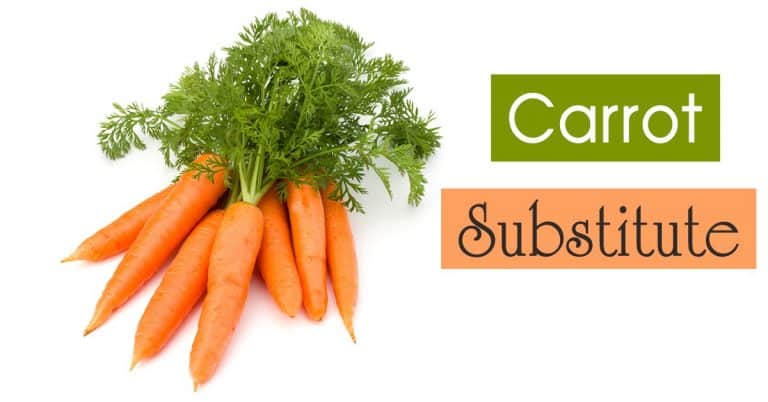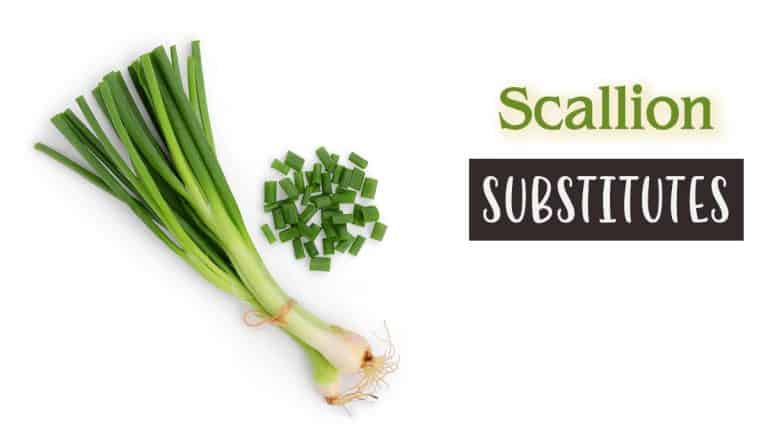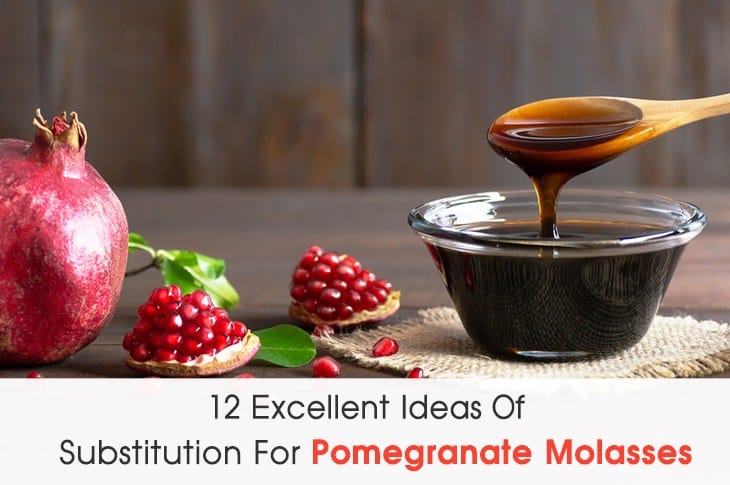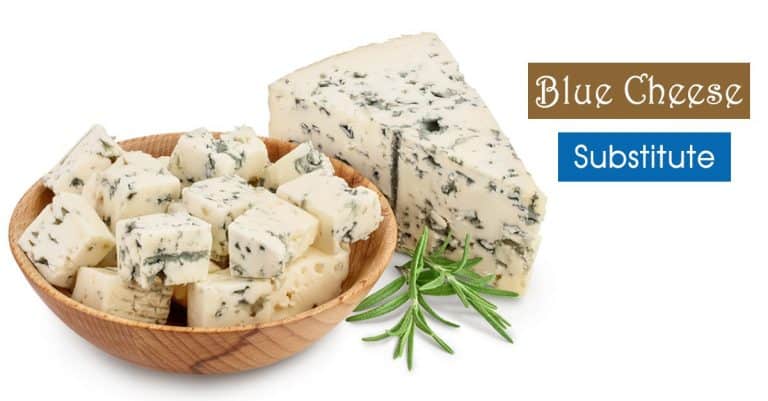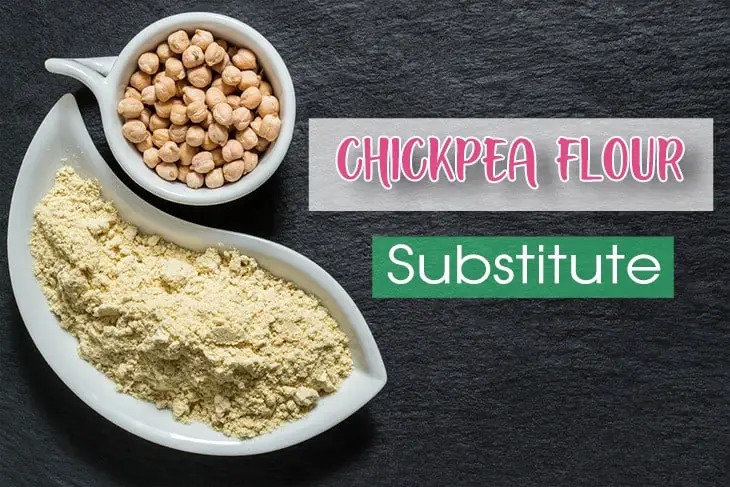
Chickpea flour is rising in popularity, so it is more likely that you will come across a recipe that lists it as an ingredient. If you don’t know what it is, this article on chickpea flour substitute will come in handy.
Chickpea flour (garbanzo bean flour), made from grinding dried chickpea (garbanzo beans) into powder, is a great source of nutrients like protein, fiber, vitamins B, and minerals. In terms of taste, it has an earthy, nutty aroma. It is the main ingredient in Indian cuisine.
Here Is The List Of 12 Chickpea Flour Substitutes For Your Consideration
Most flours on this list can be easily found at grocery stores. A few are harder to find but are still included for their unique contribution to the culinary world. Check it out!
1. All-Purpose Flour
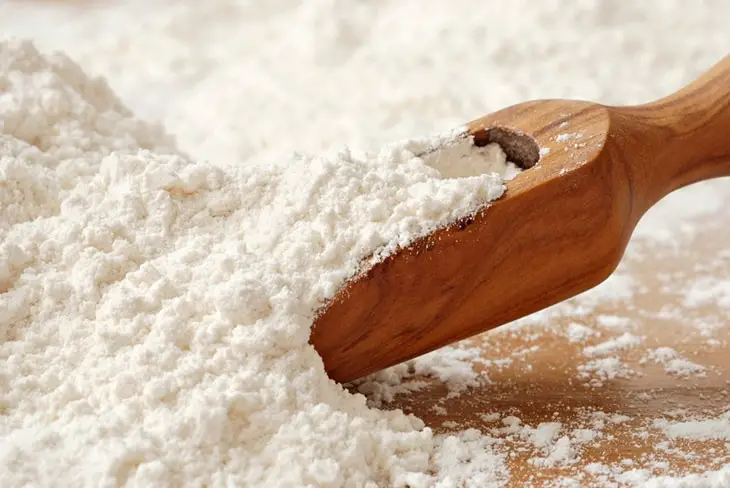
As the name suggests, all-purpose flour serves varieties of recipes. This substitute is the type of flour most often used in cooking. You can buy it easily at any grocery store.
It is made from milling, refining, and bleaching wheat grains. You may think; it must be rid of all the nutrients that wheat has to offer as a result.
Yet, manufacturers have fortified all-purpose flour. They add some of the nutrients back to the flour after the milling process.
Still, it has a considerably lower content of protein and fiber. If the baked goods you are making do not have a complex texture, chances are you can substitute it with all-purpose flour.
For your information, all-purpose flour is not actually for all purposes. Trying to use it for difficult recipes can result in failed attempts and wastes.
- Recipes: thickening agents, most baked goods, battering, and frying meat
- Nutrition facts: depending on the brands
2. Wheat Flour
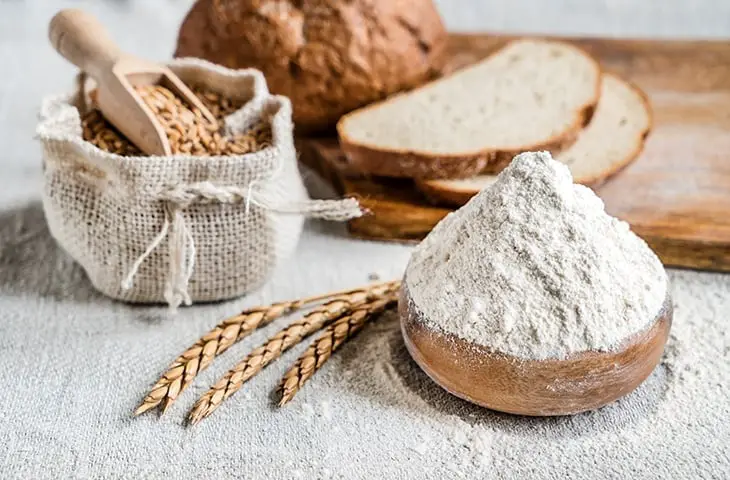
Wheat flour has more calories and carbs while less nutritional content than chickpea flour. But that doesn’t make it any less valuable as a substitute.
Since wheat flour is made from whole wheat kernel, meaning the bran, endosperm, and germ, it retains more nutrients than all-purpose flour.
Whole grain always benefits your health more, and in this case, consuming whole wheat flour lowers your risk of heart disease, obesity, cancer, and chronic inflammation.
On the other hand, the bran and the germ give the baked goods a heavier and denser texture. Most of the time, healthy options are not exactly the tastiest option.
- Recipes: bread, cookies, and scones
- Nutrition facts: fiber, folic acid, and vitamin B
3. Oat Flour / Oat Bran

Oat is a cereal grain commonly grown in the temperate climate. You must be pretty familiar with oatmeal. But what is oat flour, and how to use it?
Well, oat flour is among one of the healthiest flour options. People often associate flour and baking with cholesterol and diabetes. But do you know that when consumed in moderation, it can reduce heart-related problems, lower cholesterol, and control blood sugar?
Oat flour contains more protein and fiber than regular flour.
Furthermore, oat has a high satiety index. Foods with high satiety index make you reach the feeling of fullness quicker, thus reducing the overall calorie intake. Why don’t you make yourself some delicious pancakes from oat flour for your next breakfast to see if this is true?
In addition, there are a lot of baked goods that utilize oat flour: oatcakes, oat cookies, and oat bread. In terms of flavor, it is comparatively bland, with a tiny bit earthy and salty tones. You can use it for both cooking and baking recipes.
In case you are interested, check out these oat bran substitutions.
- Recipes: bread, pancakes, muffins, waffles, and granola bars
- Nutrition facts: gluten-free, high in protein, fiber, fat, and minerals
4. Rye Flour
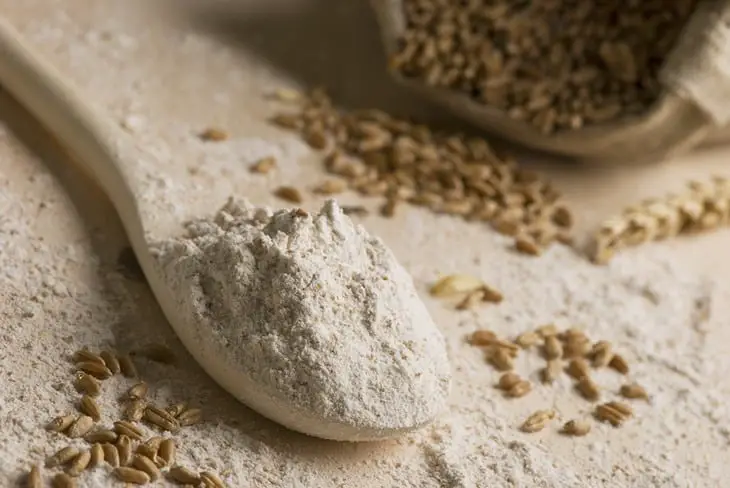
Like wheat, rye is a cereal grain that is cultivated widely. They look very alike. Both contain gluten, so people with gluten intolerance should watch out for products made from these two grains.
Unlike wheat, rye gives a more dense, earthy, and sour taste. It can be used to make an assortment of bread, with the most popular one you may have heard of is Sourdough.
Rye has a lower level of protein, fat, and minerals. Yet, it is an excellent source of a variety of vitamins compared to wheat. For a low-calorie diet, we suggest you choose this substitute; for a low-carb diet, you should choose wheat flour.
And do you know that rye flour has three varieties: light, medium, and dark? If you guess the dark one is the healthiest, you are correct. The light option is the most refined type, so the nutritious kernel is mostly taken out.
- Recipes: bread, crepe, pasta, and Kvass
- Nutrition facts: dense in nutrients (calories, protein, fat, carbohydrate, fiber, vitamin B, vitamin A, vitamin K, and vitamin E)
5. Rice Flour
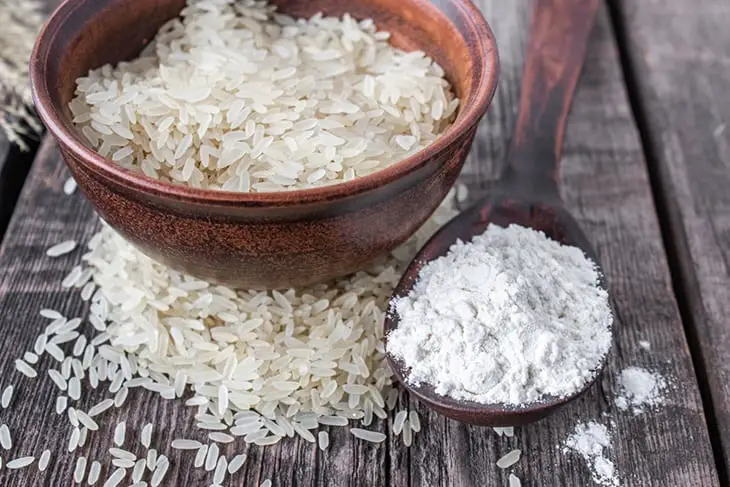
Made from rice, you can expect rice flour to taste more neutral than most flours on this list. If your main concern is that the substitute ingredient would affect the overall flavor of your dish, rice flour will solve that problem.
As rice is a staple grain, this substitute is affordable and easy to find at any grocery store. Since gluten-free baking is not exactly cheap, having it as a substitute would help lower the total cost.
And as there is more than one type of rice, there is more than one type of rice flour. You will have options like white, brown, sweet rice flours to choose from.
There are some downsides to using this option, though. It does not absorb liquid very well; therefore, it is difficult to bake with. The final products can feel gummy and gritty.
- Recipes: thickening agents (soups, sauces, gravies); curry; Banh Xeo (Vietnamese pancake), fried calamari, or tempura
- Nutrition facts: gluten-free, easy to digest, low in nutrients, high in carbs and calories
6. Corn Flour

Corn flour is milled from corn kernels. It has a fine and smooth texture like that of the rice flour, with the only difference is the color.
Because of the fine texture and the plain flavor, like rice flour, it is often used as a thickening agent. It is a very versatile ingredient since you can incorporate it into various recipes with complex flavors.
Like rice, corn is very common. Therefore, if you are looking for an economical option, then corn flour is undoubtedly very affordable.
Some health experts express their concern with GMO crops (genetically modified corn) for being applied with pesticides and herbicides.
Nonetheless, no research has proved that modified corn is toxic to the human body. If anything, gene modification is the way to help plants adapt to changing climates and solve food insecurity.
- Recipes: thickening agents (for soups, sauces, stews, casseroles), coating before frying, cookies, and tarts.
- Nutrition facts: easy to digest, rich in antioxidants and fiber.
7. Potato Flour
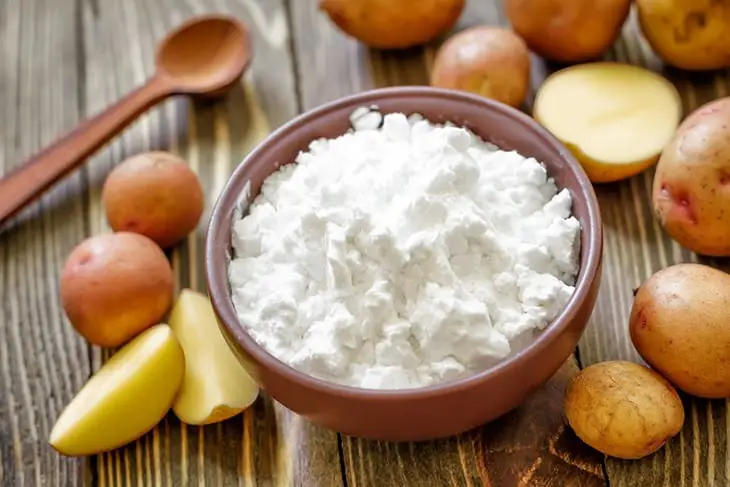
Another staple is coming up: potato flour! But first of all, why don’t we start with some disclaimer, since so many people share this same confusion? Potato flour and potato starch are two different things.
Food processor obtains potato starch by extracting starch grains from the vegetable, milling and sending them through several purification steps, and finally dewatering and drying to get the final product.
Potato flour, on the other hand, is obtained by cooking, drying, and grinding whole potatoes. In short, you can technically make your potato flours, but not potato starch, at home.
This alternative makes for light and crispy batter. Therefore, it is ideal for making light, delicate, multilayer cakes. Potato flour is rather easy to work with, so you can use it in place of most baking powder. In addition, it is not only good for baked goods but also savory dishes too.
- Recipes: pasta, thickening agents (sauces, gravies, soups), bread, rolls, cheesecakes, and doughnuts.
- Nutrition facts: carbohydrates, no fat, good bacteria for your gut.
8. Quinoa Flour
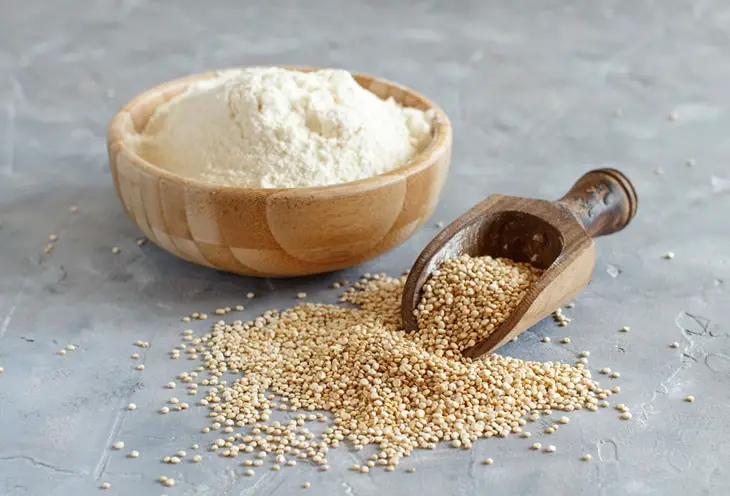
Quinoa is a flowering plant that originated from South America. Its popularity has led to the wider cultivation of this ancient grain worldwide. If rice and corn are considered staples, quinoa, on the other hand, is still treated as a luxury by many people for being pricey.
Quinoa contains more protein, vitamins, minerals, healthy fat, and fiber than more popular flour options like wheat and oat. It is also high in antioxidants, which help fight many age-related diseases.
Quinoa flour can have a tinge of sourness and bitterness to its flavor, but overall we can still say that it tastes comparatively neutral. Toasting it before using it might get rid of all the bitter taste that only those of you with extremely keen senses can feel, to begin with.
Or you can use it with strong-flavor ingredients (e.g., cocoa, onion, etc.). Any unique taste and smell the quinoa flour might have would be wiped out completely.
- Recipes: quick bread, pancakes, pizza dough, and biscuits.
- Nutrition facts: gluten-free, packed with nutrients.
9. Millet Flour

Another superfood on this list is millet flour. Millet is a more affordable choice than quinoa. Millet the grasses are highly tolerant of extreme weather conditions. They have been grown widely also for their productivity and short season.
It is also versatile for having a mild flavor. It takes on the flavor of whatever ingredients that it is cooked or baked with.
Although millet flour has many health benefits, it is advisable to use it in moderation. This grain contains some antinutrients, interfering with the absorption of other nutrients. Overconsumption can likely lead to thyroid dysfunction.
- Recipes: flatbread, pancakes, dumplings, and pie crust.
- Nutrition facts: carbohydrates, dietary fiber, calcium, and antioxidants.
10. Cassava Flour
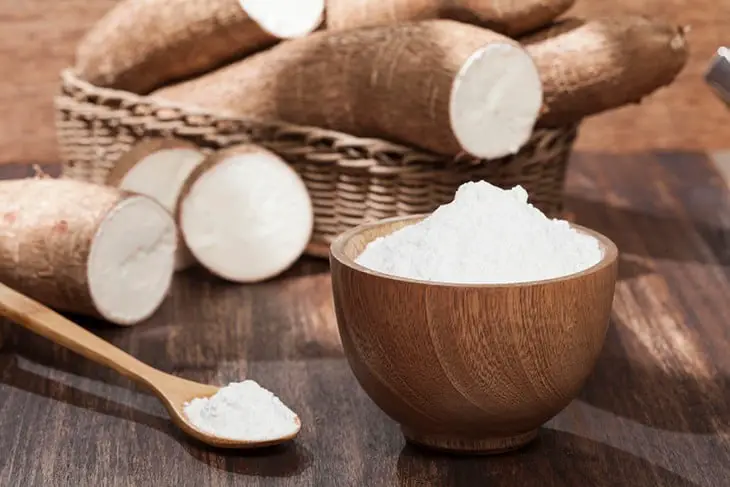
Cassava flour is made from cassava root. The cassava root contains cyanide, so it is toxic when consumed raw. However, it is completely safe when cooked or made into flour.
This alternative is gluten-free, grain-free, nut-free flour. It is the ideal ingredient for a vegan diet or a diet for people with allergies.
However, since cassava flour is very high in carbohydrates, those of you who follow a low-carb, low-sugar diet might want to be considerate of your cassava intake.
One piece of advice when using this flour is, it absorbs more liquid than the other flours on this list. For that reason, you want to use less flour and add more water than suggested by the recipe.
- Recipes: brownies and cassava pancakes.
- Nutrition facts: allergy-friendly, a good source of vitamin C and fiber.
11. Coconut Flour

A rising star in the gluten-free world, coconut flour starts to appear in more and more recipes. You don’t have to use it just so you can be on-trend, though. There are more practical reasons why this flour should be on your to-try list.
Coconut flour has high protein content, which is a good thing if you are on a vegan or vegetarian diet. It is high in healthy fat and fiber, beneficial for your heart and digestive health.
Those who are on a diet also might want to watch out for the calorie intake when using coconut flour. Furthermore, it has a low glycemic index thus can help control your blood sugar spikes.
Coconut flour is in the group of flours on this list with distinct flavors. It has a tropical sweet flavor. If you are not a fan of coconut, this type of flour is probably not for you either.
But if you love its taste, here are some tips for using coconut flour. It is very absorbent, so do not substitute it at a 1:1 ratio for other flours.
Add more eggs for baking recipes so that they can help bind the flour better. In addition, since coconut flour is thick, don’t use this to make food or baked goods that require a crispy texture.
- Recipes: thickening agents, cakes, muffins, and bread.
- Nutrition facts: gluten-free, rich in protein, fat, and fiber.
12. Almond Flour
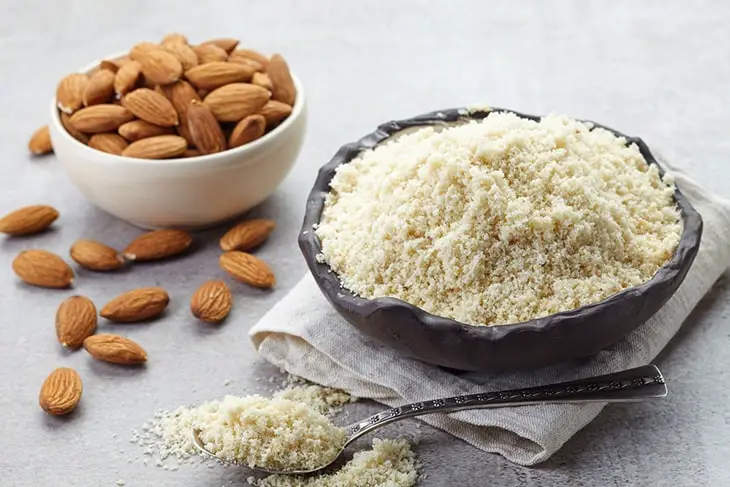
Another representative from the gluten-free group: almond flour. Almond flour is also the most popular low-carb flour.
It is made from blanched and finely ground almonds. This flour has a sweet and nutty flavor. Even though it is not the most economical option out there, you should give it a try whenever possible.
Due to its fat content, almond flour is not a good alternative when baking crusty bread since it would make the final product flat and dense. It is best used for moist bake treats like cupcakes or muffins.
Like the nut, almond flour is an incredible source of nutrients. It is good for your heart health and digestive health. It is among the best options for diabetic problems, too, since it has fewer sugar and carbohydrates.
- Recipes: muffin, cake, cookies, and macaroons.
- Nutrition facts: gluten-free, vitamin E, and magnesium.
Frequently Asked Questions
Flour Shelf Life And Storage
Flour has a long shelf life, but if you think you can store it forever, you are wrong. In general, flour goes bad after 6-12 months. The shelf life depends on the fat content of each type of flour. Refined flours last longer than whole-grain flours.
Most flour packages have an expiration date on them, though the date is just an estimate. How long your flour lasts also depends on the way you store it. The best environment to store flour is somewhere dry, cool, dark, and airtight.
Although it is hard, there are some ways to tell if your flour has gone bad. If it smells off, looks discolored, has clumps of mold, you should throw it out right away. You want to do the same thing with flour that is way past the expiration date for your health and safety.
Mixing Different Types Of Flour
The list above provides some chickpea flour substitute suggestions for you, though you shouldn’t limit yourself to using strictly one type of flour at a time. Indeed, using different types of flour at the same time can provide some wonderful results.
This trick is extremely helpful when you have a little leftover of different types of flour and don’t want to waste your money buying a new bag. Or in case the recipe suggests the type of flour that is not exactly the healthiest option, and you want to mix in some beneficial flour for your own good.
One thing to consider when mixing flours is that they aren’t interchangeable, as we mention above. They can produce some adjustments in flavor or texture, and precision is particularly crucial with baking more than cooking.
So, unless you are someone who knows the characteristics of these flours well or are making a relatively common recipe, we’d say let’s not experiment with this mixing method.
Gluten Intolerance
Since chickpea flour is gluten-free, the chickpea flour substitute you are looking for is likely to be gluten-free as well.
There are several candidates on this list that meet the requirement. However, be mindful when you go shopping for them, especially if you are diagnosed as gluten-tolerant.
Some flours are gluten-free by definition, but the reality is, they become impure after all the processing. Be prudent and read the package label carefully.
Also, if you are not the one directly carrying out the recipe, notifying the person who does the cooking or baking of your gluten intolerance so that they are more careful when handling the ingredients.
Conclusion
All things said, there is no “perfect” substitute for chickpea flour, despite there being no lack of flour variety.
Chickpea has its own earthy, nutty taste that can’t be perfectly imitated. Some recipes list chickpea flour as an ingredient for a reason.
Nevertheless, if getting chickpea flour where you are is difficult, the list above provides some good alternatives for you to consider, both non-gluten-free and gluten-free flours.
Hope you can find a suitable chickpea flour substitute for your favorite recipe and good luck!

